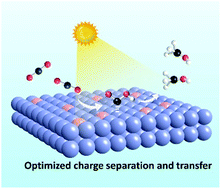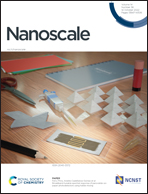Ultrathin Ti-doped WO3 nanosheets realizing selective photoreduction of CO2 to CH3OH†
Abstract
Arduous CO2 activation and sluggish charge transfer retard the photoreduction of CO2 to CH3OH with high efficiency and selectivity. Here, we fabricate ultrathin Ti-doped WO3 nanosheets possessing approving active sites and optimized carrier dynamics as a promising catalyst. Quasi in situ X-ray photoelectron spectroscopy and synchrotron–radiation X-ray absorption near-edge spectroscopy firmly confirm that the true active sites for CO2 reduction are the W sites rather the Ti sites, while the Ti dopants can facilitate charge transfer, which accelerates the generation of crucial COOH* intermediates as revealed by in situ Fourier-transform infrared spectroscopy and density functional theory calculations. Besides, the Gibbs free energy calculations also validate that Ti doping can lower the energy barrier of CO2 activation and CH3OH desorption by 0.22 eV and 0.42 eV, respectively, thus promoting the formation of CH3OH. In consequence, the Ti-doped WO3 ultrathin nanosheets show a superior CH3OH selectivity of 88.9% and reach a CH3OH evolution rate of 16.8 μmol g−1 h−1, about 3.3 times higher than that on WO3 nanosheets. This work sheds light on promoting CO2 photoreduction to CH3OH by rational elemental doping.

- This article is part of the themed collections: CO2 capture and conversion, Nanoscale 2023 Lunar New Year Collection and 2022 Nanoscale HOT Article Collection


 Please wait while we load your content...
Please wait while we load your content...